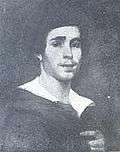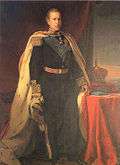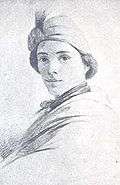José Rodrigues
| José Rodrigues | |
|---|---|
|
Self portrait of José Rodrigues | |
| Born |
José Rodrigues de Carvalho July 16, 1828 Lisboa, Portugal |
| Died |
February 18, 1887 (aged 58) Lisboa |
| Nationality | Portuguese |
| Education | Academy of Fine Arts |
| Known for | painting |
| Notable work | See Gallery |
| Movement | Realism |
| Awards |
by the Queen Dona Maria II - Gold medal |

José Rodrigues de Carvalho (Lisbon, July 16 - 1828 — Lisbon, October 19, 1887) was a Portuguese painter.
Considered his most famous work, O Pobre Rabequista (The poor rabequista), painted in 1855, was first shown in Paris at the Universal Exhibition in 1855 and at the International Exposition of Porto in 1865, where he won the second award.
Biography
Early life
José Rodrigues, son of Apolinário José de Carvalho and Maria Leonarda, was baptised in "São João da Praça" on September 21, 1828, having as godfather José Rodrigues.
José Rodrigues (his homonym) had five brothers and lived at the "Rua dos Bacalhoeiros" in Lisbon, having married in 1863 with D. José Maria Rodrigues, daughter of José Rodrigues da Rocha, having also three children named (António Ribeiro Rodrigues, Teresa de Jesus Rodrigues and Leonor Matilde Rodrigues).
Prior to join the Academy of Fine Arts at (San Francisco Convent) as a volunteer student in 1841, he left an engraving dated of 1840. The existence of a colleague at the Academy also homonym, he officially requested the reduction of its name to "José Rodrigues." At fourteen years of age, in the drawing competition history, he won a prize in a copy of a bas-relief, modelling from student to student. From that time (1842) there still remains an engraving, signed and dated by José Rodrigues.
In 1843, during an exhibition of Works by students, he presented a drawing in bas-relief. In that year, each of the following received an award: Miguel Ângelo Lupi, Angelino da Cruz Castro e Silva, António José Lopes Júnior and Ernesto Gerard. In the academic year of 1845/1846, he entered higher education in the subject of historical painting and won an award. In December 1846, he was attributed another award for a life-model drawing.
Classmates
Some of José Rodrigues’ classmates were João Pedro Monteiro (Monteirinho), Francisco Augusto Metrass, Tomás da Anunciação, Joaquim Pedro de Sousa, António José Patrício, amongst others.
Awards
At the triennial exhibition of 1849, he was awarded with a gold medal by the Queen, Dona Maria II.
At its conference in August 1849, the Academy of Fine Arts awarded José Rodrigues with a gold medal for his painting, Aparição do Anjo S. Gabriel ao profeta Daniel.[1]
At an exhibition, promoted by the Portuguese Industrial Association, José Rodrigues received the Silver Medal with honours.
In 1865, he was nominated “Academic of Merit” at the Academy of Fine Arts’ General Conference.
Throughout his life, against his wishes, he was forced to paint portraits in order to survive; a fact which caused him to become melancholic and given to illness. He gave classes at the Irish-owned "Monastery of Bom-Sucesso" and at the private school, "S. José das Dominicanas de S. Domingos de Benfica", amongst others.
The artist died at his home in Rua dos Bacalhoeiros, Lisbon, on October the 19th, 1887.
Reviews of his work





- According to José Augusto França, the artist dedicated himself to the painting of customs, within a sphere of sentimental realism and his work was hindered by a difficulty in separating sentimentalism from realism.[2]
Diverse
- The Works of José Rodrigues and other contemporaries of his time are being studied within the subject of 19th Century Art (The Romantic Movement) at the Faculty of Arts of the University of Oporto.[3]
- On November the 16th 1882, the artist entered into an agreement with the City Council of Lisbon for the production of two paintings for the Council’s main “Meeting Chamber”.
In the contract, José Rodrigues committed himself to the creation of two real-life and full-body paintings of Alexandre Herculano (1810–1877) and Manuel Fernandes Tomás (1771–1822), in memory of their noble life contributions. The contract was signed by the presiding Chairman of the Council, José Gregório da Rosa Araujo and by the artist. The paintings currently exposed in the “Meeting Chamber” of the City Council.[4]
Selected works
- For lack of private health and other reasons, i take up two years without brushes, ... Today April 21, 1883, wishing to continue this relationship and far as i remember, without having signed order, are:
Oil paintings
- The poor of púcara in half body. It belonged to the king D. Fernando
- The poor rabequista (or Blind Rabequista), composition of three figures in natural size. It belonged to the king - Fernando and then to Mr. Conde do Ameal and currently is part of the booty Chiado Museum.
- The malmequer. It belonged to D. Rufina Maria Iglesias of Lima.
- Cliffs of La Mancha. He belonged to the Marquis de Sousa Holstein.
- The old vegetable seller in Sintra. It belonged to the king D. Luis.
- The peasant. It belonged to the king - D. Luis.
- Margins of the Tagus river, around Santarém. It belonged to the king - Luis.
- Lady of Good luck. It belonged to D. Rufina Maria Iglesias of Lima.
- Flowers and fruit; height 1.72 m. It belonged to the king D. Fernando.
- The city, under the roof of the hall of great sessions of the Municipal Council of Lisbon. 5.m long, for 4.m high. 1883.
Oil portraits
- His Majesty the King - Pedro V, reminiscent, in transparent, to celebrate the Aclamação in Beja.
- Adviser Jose da Silva Carvalho, a copy to Portalegre. 85. Anonymous.
- His Eminence Cardinal Patriarch of Lisbon, D. Manuel Bento Rodrigues, to Braga.
- His Majesty the King - Pedro V, for the hall of the Commerce Square in Lisbon.
- His Majesty the King - Louis to the chamber of capelos the University of Coimbra, part of 3.m tall.
- His Majesty the King - Pedro V (reminiscent of) to school Mafra, order of Madrépora Society of Rio de Janeiro.
- His Majesty the King - Luis, for the Ministry of the Navy to the palace of the Government in Mozambique, part of 2.60 by 1.70 m.
- His Majesty the King - Luis, to the House of deputy.
- His Majesty the King - Pedro V, reminiscent, for the Society of Rio de Janeiro, part of 2.me 50, by 1.me 50.
- Self-portrait of the artist, at nineteen years of age.
- Self-portrait of the painter, dressed in cape and hat.
Bibliography
- Monograph "José Rodrigues, pintor português" by Júlio de Castilho (1909)
- Armando de Lucena "Pintores Portugueses do Romantismo"
- Painting gallery of the Palácio Nacional da Ajuda (catalogue, 1869) and 1.ª Exhibition of retrospective art - 1880 a 1933 (catalogue, 1937)
- Four Romantic Painters (colecção Museum, 1ª série, nº 6 de 1949 - edited by Museu Nacional de Arte Contemporânea)
- O Traço e a Cor (Drawings and watercolours from José Malhoa Museum) - edited for the Museum by the Portuguese Patrimony Cultural Institute in 1988)
- Olisipo (Bulletin from group of "Amigos de Lisboa") - (Year XX, nº 78 of April, 1957)
- D. Fernando II - A German Mecenas, Regent of Portugal (Marion Ehrhardt, edited by - Livraria Estante Editora em 1989 ? )
- Os Paços do Concelho - Lisboa (edited by Lisboa Municipally with Salette Simões Salvado text, 1982)
- History of Art in Portugal (neoclassic's and romanticism) - (Publicações Alfa with Regina Anacleto text, 1986)
External links
- José Rodrigues Biography
- Virtual visit to Portuguese Parliament(Senate chamber)
- City Council (Lisboa Municipally)
- Portrait´s serving history
- Chiado Museum
- Five Artists in Sintra (Chiado Museum)
References
- ↑ Fine Arts Academy of Lisboa Diploma
- ↑ Art in Portugal at the XIX Century (Volume I - Livraria Bertrand - 1966)
- ↑ Faculdade de Letras da Universidade do Porto
- ↑ Study for the roof of the Noble Chamber of Lisbon Municipy
| Wikimedia Commons has media related to José Rodrigues. |